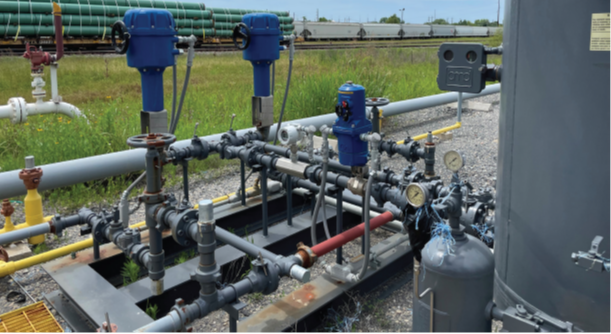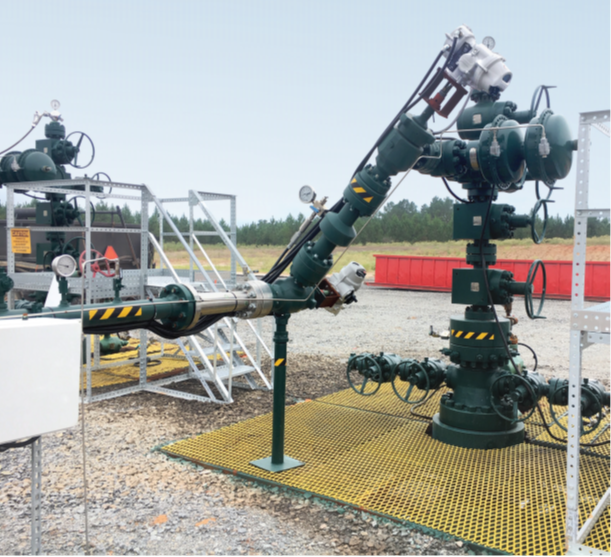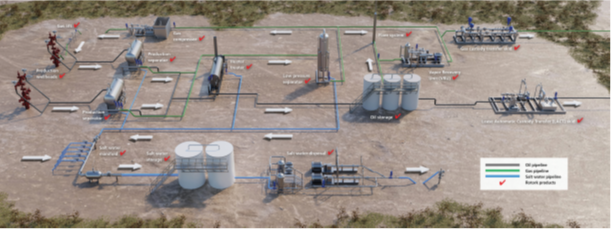It has become increasingly imperative for governments and businesses worldwide to prioritize the reduction of total methane emissions generated by industrial processes. The oil and gas sector emits around 80 Mt of methane annually, accounting for roughly 40% of total human-cause methane emissions. These emissions may be reduced by over 75% by implementing leak and detection repair programs and upgrading leaky equipment. Methane abatement in oil and gas is highly cost-effective, and approximately 40% of methane emissions may be eliminated at no net cost.1
By Chris Hardy, Head of Strategy for Oil & Gas – Rotork
Electric actuation emerges as a dependable, cost-effective, and suitable solution for operators to achieve methane emissions reduction objectives. This article explores the benefits of utilizing intelligent electric actuation to decrease methane emissions across upstream oil and gas processes, thereby enhancing efficiency, mitigating risks, and improving uptime.
Electric Over Pneumatic Actuation
Traditionally, oil and gas applications have favored spring-return and diaphragm actuators powered by processed gas, especially in remote or extreme conditions. However, transitioning to electrically powered flow control can eliminate vented gas. Within the oilfield infrastructure, pneumatic diaphragm actuators have been standard, constantly venting methane as they modulate. Replacing pneumatic actuators with electric flow control solutions is an effective way to reduce upstream methane emissions.
Electric actuators demand significantly lower maintenance when compared to pneumatic actuators and control instruments.
Using self-contained electric actuators instead of pneumatic solutions with multiple parts and systems results in cost savings and increased operational efficiency. Electric actuators, such as Rotork’s intelligent IQ3, CMA, and CVA process control actuators, for example, feature user-friendly interfaces and software tools that simplify the commissioning process, making them a perfect solution for upstream applications.
Electric actuator technologies offer numerous benefits compared to pneumatic ones. Pneumatic actuators can be affected by environmental factors such as air quality fluctuations and temperature variations due to their intricate structure. On the other hand, electric actuators are less susceptible to such influences. They are more energy efficient as they only consume electricity when in operation. In contrast, pneumatic actuators and controls require a constant supply of either motive pipeline gas or a compressed air supply.
Many electric actuators come with fail-to-position options that automatically return valves to a predetermined position in case of power loss or emergencies. This measure improves safety and prevents possible damage to equipment. They are also equipped with advanced diagnostic features that enable remote monitoring of their conditions, performance, and potential issues. This proactive approach enables early identification and resolution of problems, preventing unexpected failures and associated downtime.

Electric Actuation Solutions
Actuators and controllers are critical components that must deliver higher performance and dependability. Intelligent flow control solutions provide:
Advanced control: Actuators can provide the necessary torques and thrusts while operating at the required speeds for choke and process control valves in upstream applications. In addition, they offer the highest resolution output and modulating duty for accurate pressure and flow rate control.
High reliability: Intelligent electric actuators are designed to provide reliable and repeatable performance in the dynamic and challenging environments of remote oil and gas well sites. They monitor temperature, torque, and voltage to ensure the unit’s integrity and operating performance, resulting in a longer product lifespan.
Lower power consumption: Actuation solutions can be energy-efficient and use little electrical power, whether optimizing in-field solar power infrastructure in remote locations or effectively managing an escalator environment with higher-priced available grid power.
Field serviceability: In-field interventions must be rapid and simple, whether carried out remotely, in control rooms, or by physical interaction with the actuator.
Electric actuators are suitable for upstream applications such as gas metering, production trees, processing, saltwater disposal, and gas lift systems. The specific benefits of electric actuation are evident across upstream applications.
Production Trees
A production tree (often called a Christmas tree) comprises valves, spools, and fittings essential for regulating the flow of oil or gas from a well. In case of over- pressure, a Surface Safety Valve (SSV) is a fail-safe/shutdown valve installed at the upper wellbore to execute emergency shutdowns, safeguarding the production tunings. Meanwhile, a production choke valve manages the flow of well fluids and regulates downstream pressure in the flowlines.
Electric actuators are designed for advanced production choke valve operation. They offer non-intrusive operation, easy setup, proportional control, high precision, and low power consumption. They are lightweight, compact, and durable. For example, the Rotork Modular Electro-Hydraulic Solution combines the simplicity of electrical operation with the high torque/thrust and fail-safe fast-action capabilities of hydraulic high-pressure control. This solution is used for rotary and linear valve actuation for fail-safe operation of the SSV valve.

Production Processing
Pneumatic diaphragm actuators have traditionally been used to operate control valves in the upstream production process. These actuators primarily use well-stream process gas to power the valve, releasing methane every time the valve is stroked.
Many operators have adopted compressed air as an alternative energy source, deploying air compressor units at production sites. For example, Rotork’s electric control valve actuators offer a more advanced and energy-efficient solution. These actuators are suitable for dump valves and back-pressure control valves, commonly used in upstream production processing applications. These actuators not only help achieve net-zero emissions with a solar-powered 24 VDC supply option but also help reduce overall life cycle costs compared to the instrument air actuator alternative.
Gas Metering and LACT Skids
Gas metering and Lease Automatic Custody Transfer (LACT) skids connect upstream operations to midstream gathering infrastructure. These systems ensure accurate measurement of natural gas production and oil custody transfer. Compared to upstream processing infrastructure, midstream, pipelines and valves are typically larger and require higher torque/thrust ranges for valve actuation.
Multiple flow control systems work together on a custody transfer metering skid to ensure precise measurement and accuracy. The accuracy and reliability of flow control on metering skids must always ensure safe valve operation. To automate large control valves with high-pressure ratings, a high-output actuator such as the CML can be used to deliver increased linear thrust and stroke length.
CVA (quarter-turn and linear) are highly accurate and responsive, without the complexity and cost of a pneumatic supply. For LACT valve actuation applications that require a lower modulating duty cycle, the IQT3M Pro, for example, is suitable because it provides a torque range and speed that are well-suited to the requirements. Additionally, it has a duty cycle of 1800 starts per hour.

Gas Lift Systems
When extracting oil from underground wells, a gas lift system is used to lift the fluids to the surface. This system injects high-pressure gas into the well, achieving two crucial effects. Firstly, the injected gas reduces the density of the well fluids, making them flow more easily. Secondly, the gas creates a “scrubbing” effect, lowering the pressure at the bottom of the well and aiding the fluid flow.
The effectiveness of a gas lift system relies heavily on a reliable and sufficient supply of high-quality lift gas. A control valve modulates the flow and pressure of the gas injected into the well. For example, the CMA electric actuator is well-suited for this application. It is designed to operate precisely and continuously, making it suitable for modulation applications like gas lift systems. It is capable of continuously modulating up to S9/Class D with up to 0.2% accuracy for accurate and repeatable position control. This does well for use in backpressure lines in gas compressors and throttling valves on gas lift metering skids. This ensures that the desired injection fl ow rates and pressures are maintained.
Saltwater Disposal Systems
Produced water is the largest liquid produced in the oil and gas industry. The volume of water from a well can be up to five times the volume of gas or oil produced from the same well. This water is transported through a gathering line network to recycling tanks or saltwater disposal wells.
The entire system is equipped with multiple actuated valves to ensure the safe and efficient control of produced water flow. Most control valves in water infrastructure require precise control to prevent water hammering. It is essential for back-pressure control valves to operate at high-frequency modulation duty to optimize the performance of water injection pumps. For example, Rotork’s CMQ and IQT3M Pro actuators offer adjustable settings for speed, torque/thrust protection, high accuracy, high-resolution micro-step movement, and a slow mode for precise positioning.
Conclusion
Advanced automation solutions can help operators reduce emissions, improve process efficiency, and increase production output reliably. Electrifying valve actuation can help reduce the methane emissions produced by oil and gas operations. Selecting low-power solutions suitable for upstream oil and gas processes can help operators achieve emissions reduction targets.



